A New Model for Real-Time Prediction of Wellbore Stability Considering Elastic and Strength Anisotropy of Bedding Formation
Abstract
:1. Introduction
2. Stress Distribution around Wellbore in Anisotropic Bedding Rocks
2.1. Basic Equations for Drilling in Elastic Anisotropic Rocks
2.2. Solutions for Stress Distribution around Wellbore
3. Failure Criteria Considering Strength Anisotropy of Rocks around Wellbore
3.1. Collapse Failure of Rock Matrix
3.2. Collapse Failure of Weak Planes
3.3. Fracture Failure of Rocks
4. Real-Time Prediction of Safe Drilling Mud Weight in Anisotropic Bedding Formation
4.1. Tensor Transformations between Different Coordinate Systems
4.1.1. Stress Tensor Transformation
4.1.2. Compliance Tensor Transformation
4.2. Flowchart for Programing
5. Calculation Results and Analyses of the Case in Real Field
5.1. Calculation Results of the Case with Generality
5.1.1. Stress Distribution around the Wellbore
5.1.2. Failure Area around the Wellbore
5.1.3. Collapse Stress and Fracture Stress
5.2. Factors Influencing the Safe Mud Weight Window
5.2.1. In Situ Stress
5.2.2. Orientation of Wellbore
5.2.3. Orientation of Weak Planes
5.2.4. Elastic Anisotropy
5.3. Real-Time Calculation and Prediction in Drilling Process
6. Conclusions
- Based on the model built in this paper and the method developed for programming, it is convenient to calculate the stress distribution, failure area, collapse and fracture pressure around a general wellbore in anisotropic bedding formations.
- All the factors of in situ stress, directions of wellbore and weak planes, and anisotropic elastic parameters have significant influences on the SMWW: the ratio of horizontal in situ stress () and elastic parameters (, ) affect the upper limit of SMWW greater than the lower limit; negative SMWW may appear with the change of the wellbore’s (or weak plane’s) orientation, especially when the azimuth of the well (weak plane) changes; considering elastic anisotropy, the effects of Young’s modulus on the SMWW is greater than the Poisson’s ratio.
- The anisotropic characteristics of bedding rocks cannot be neglected when assessing wellbore stability and the method established in this paper can greatly help with the precise prediction of safety issues as drilling proceeds.
Author Contributions
Funding
Institutional Review Board Statement
Informed Consent Statement
Conflicts of Interest
References
- Steiger, R.P.; Leung, P.K. Quantitative Determination of the Mechanical Properties of Shales. SPE Drill. Eng. 1992, 7, 181–185. [Google Scholar] [CrossRef]
- Gaede, O.; Karpfinger, F.; Jocker, J.; Prioul, R. Comparison between Analytical and 3D Finite Element Solutions for Borehole Stresses in Anisotropic Elastic. Int. J. Rock Mech. Min. Sci. 2012, 51, 53–63. [Google Scholar] [CrossRef] [Green Version]
- Meier, T.; Rybacki, E.; Backers, T.; Dresen, G. Influence of Bedding Angle on Borehole Stability: A Laboratory Investigation of Transverse Isotropic Oil Shale. Rock Mech. Rock Eng. 2015, 48, 1535–1546. [Google Scholar] [CrossRef]
- Lee, H.; Ong, S.H.; Azeemuddin, M.; Goodman, H. A Wellbore Stability Model for Formations with Anisotropic Rock Strengths. J. Pet. Sci. Eng. 2012, 96–97, 109–119. [Google Scholar] [CrossRef]
- Nasseri, M.H.B.; Rao, K.S.; Ramamurthy, T. Anisotropic Strength and Deformational Behavior of Himalayan Schists. Int. J. Rock Mech. Min. Sci. 2003, 40, 3–23. [Google Scholar] [CrossRef]
- Aadnoy, B.; Hareland, G.; Kustamsi, A.; de Freitas, T.; Hayes, J. Borehole Failure Related to Bedding Plane. In Proceedings of the 43rd US Rock Mechanics Symposium & 4th US-Canada Rock Mechanics Symposium 2009, Asheville, NC, USA, 28 June–1 July 2009. [Google Scholar]
- Chenevert, M.E.; Gatlin, C. Mechanical Anisotropies of Laminated Sedimentary Rocks. Soc. Pet. Eng. J. 1965, 5, 67–77. [Google Scholar] [CrossRef]
- Geng, Z.; Chen, M.; Jin, Y.; Yang, S.; Yi, Z.; Fang, X.; Du, X. Experimental Study of Brittleness Anisotropy of Shale in Triaxial Compression. J. Nat. Gas Sci. Eng. 2016, 36, 510–518. [Google Scholar] [CrossRef]
- Yan, C.; Deng, J.; Cheng, Y.; Li, M.; Feng, Y.; Li, X. Mechanical Properties of Gas Shale During Drilling Operations. Rock Mech. Rock Eng. 2017, 50, 1753–1765. [Google Scholar] [CrossRef]
- Gale, J.F.W.; Holder, J. Natural Fractures in the Barnett Shale: Constraints on Spatial Organization and Tensile Strength with Implications for Hydraulic Fracture Treatment in Shale-Gas Reservoirs. In Proceedings of the 42nd US Rock Mechanics Symposium (USRMS), San Francisco, CA, USA, 29 June–2 July 2008. [Google Scholar]
- Mokhtari, M.; Tutuncu, A.N. Impact of Laminations and Natural Fractures on Rock Failure in Brazilian Experiments: A Case Study on Green River and Niobrara Formations. J. Nat. Gas Sci. Eng. 2016, 36, 79–86. [Google Scholar] [CrossRef]
- Niandou, H.; Shao, J.F.; Henry, J.P.; Fourmaintraux, D. Laboratory Investigation of the Mechanical Behaviour of Tournemire Shale. Int. J. Rock Mech. Min. Sci. 1997, 34, 3–16. [Google Scholar] [CrossRef]
- Wang, Z. Seismic Anisotropy in Sedimentary Rocks, Part 2: Laboratory Data. Geophysics 2002, 67, 1423–1440. [Google Scholar] [CrossRef]
- Cho, J.-W.; Kim, H.; Jeon, S.; Min, K.-B. Deformation and Strength Anisotropy of Asan Gneiss, Boryeong Shale, and Yeoncheon Schist. Int. J. Rock Mech. Min. Sci. 2012, 50, 158–169. [Google Scholar] [CrossRef]
- Ong, S.H. Borehole Stability. Ph.D. Thesis, The University of Oklahoma, Norman, OK, USA, 1994. [Google Scholar]
- Suarez-Rivera, R.; Green, S.J.; McLennan, J.; Bai, M. Effect of Layered Heterogeneity on Fracture Initiation in Tight Gas Shales. In Proceedings of the SPE Annual Technical Conference and Exhibition 2006, San Antonio, TX, USA, 24–27 September 2006. [Google Scholar]
- Bradley, W.B. Failure of Inclined Boreholes. J. Energy Resour. Technol. 1979, 101, 232–239. [Google Scholar] [CrossRef]
- Ding, L.; Wang, Z.; Liu, B.; Lv, J. Assessing Borehole Stability in Bedding-Parallel Strata: Validity of Three Models. J. Pet. Sci. Eng. 2019, 173, 690–704. [Google Scholar] [CrossRef]
- Wang, J.; Weijermars, R. New Interface for Assessing Wellbore Stability at Critical Mud Pressures and Various Failure Criteria: Including Stress Trajectories and Deviatoric Stress Distributions. Energies 2019, 12, 4019. [Google Scholar] [CrossRef] [Green Version]
- Detournay, E.; Cheng, A.H.-D. Poroelastic Response of a Borehole in a Non-Hydrostatic Stress Field. Int. J. Rock Mech. Min. Sci. Geomech. Abstr. 1988, 25, 171–182. [Google Scholar] [CrossRef]
- Cui, L.; Abousleiman, Y.; Cheng, A.H.-D.; Roegiers, J.-C. Time-Dependent Failure Analysis of Inclined Boreholes in Fluid-Saturated Formations. J. Energy Resour. Technol. 1999, 121, 31. [Google Scholar] [CrossRef]
- Ding, L.; Wang, Z.; Liu, B.; Lv, J.; Wang, Y. Borehole Stability Analysis: A New Model Considering the Effects of Anisotropic Permeability in Bedding Formation Based on Poroelastic Theory. J. Nat. Gas Sci. Eng. 2019, 69, 102932. [Google Scholar] [CrossRef]
- McTigue, D.F. Thermoelastic Response of Fluid-Saturated Porous Rock. J. Geophys. Res. 1986, 91, 9533. [Google Scholar] [CrossRef]
- Kurashige, M. A Thermoelastic Theory of Fluid-Filled Porous Materials. Int. J. Solids Struct. 1989, 25, 1039–1052. [Google Scholar] [CrossRef]
- Wu, B.; Zhang, X.; Jeffrey, R.G.; Wu, B. A Semi-Analytic Solution of a Wellbore in a Non-Isothermal Low-Permeability Porous Medium under Non-Hydrostatic Stresses. Int. J. Solids Struct. 2012, 49, 1472–1484. [Google Scholar] [CrossRef] [Green Version]
- Ding, L.; Wang, Z.; Wang, Y.; Liu, B. Thermo-Poro-Elastic Analysis: The Effects of Anisotropic Thermal and Hydraulic Conductivity on Borehole Stability in Bedding Formations. J. Pet. Sci. Eng. 2020, 190, 107051. [Google Scholar] [CrossRef]
- Huan, X.; Xu, G.; Zhang, Y.; Sun, F.; Xue, S. Study on Thermo-Hydro-Mechanical Coupling and the Stability of a Geothermal Wellbore Structure. Energies 2021, 14, 649. [Google Scholar] [CrossRef]
- Chen, X.; Tan, C.P.; Detournay, C. A Study on Wellbore Stability in Fractured Rock Masses with Impact of Mud Infiltration. J. Pet. Sci. Eng. 2003, 38, 145–154. [Google Scholar] [CrossRef]
- Kanfar, M.F.; Chen, Z.; Rahman, S.S. Analyzing Wellbore Stability in Chemically-Active Anisotropic Formations under Thermal, Hydraulic, Mechanical and Chemical Loadings. J. Nat. Gas Sci. Eng. 2017, 41, 93–111. [Google Scholar] [CrossRef]
- Aslannezhad, M.; Keshavarz, A.; Kalantariasl, A. Evaluation of Mechanical, Chemical, and Thermal Effects on Wellbore Stability Using Different Rock Failure Criteria. J. Nat. Gas Sci. Eng. 2020, 78, 103276. [Google Scholar] [CrossRef]
- Li, X.; Jaffal, H.; Feng, Y.; El Mohtar, C.; Gray, K.E. Wellbore Breakouts: Mohr-Coulomb Plastic Rock Deformation, Fluid Seepage, and Time-Dependent Mudcake Buildup. J. Nat. Gas Sci. Eng. 2018, 52, 515–528. [Google Scholar] [CrossRef]
- Guo, Z.Y.; Wang, H.N.; Jiang, M.J. Elastoplastic Analytical Investigation of Wellbore Stability for Drilling in Methane Hydrate-Bearing Sediments. J. Nat. Gas Sci. Eng. 2020, 79, 103344. [Google Scholar] [CrossRef]
- He, S.; Wang, W.; Zhou, J.; Huang, Z.; Tang, M. A Model for Analysis of Wellbore Stability Considering the Effects of Weak Bedding Planes. J. Nat. Gas Sci. Eng. 2015, 27, 1050–1062. [Google Scholar] [CrossRef]
- Ma, T.; Zhang, Q.B.; Chen, P.; Yang, C.; Zhao, J. Fracture Pressure Model for Inclined Wells in Layered Formations with Anisotropic Rock Strengths. J. Pet. Sci. Eng. 2017, 149, 393–408. [Google Scholar] [CrossRef]
- Deangeli, C.; Omwanghe, O. Prediction of Mud Pressures for the Stability of Wellbores Drilled in Transversely Isotropic Rocks. Energies 2018, 11, 1944. [Google Scholar] [CrossRef] [Green Version]
- Lekhnitskii, S.G.; Fern, P.; Brandstatter, J.J.; Dill, E.H. Theory of Elasticity of an Anisotropic Elastic Body. Phys. Today 1964, 17, 84. [Google Scholar] [CrossRef]
- Amadei, B. Rock Anisotropy and the Theory of Stress Measurements; Lecture Notes in Engineering; Springer: Berlin/Heidelberg, Germany, 1983; Volume 2, ISBN 978-3-540-12388-0. [Google Scholar]
- Aadnoy, B.S. Modelling of the Stability of Highly Inclined Boreholes in Anisotropic Rock Formations. SPE Drill. Eng. 1987, 3, 259–268. [Google Scholar] [CrossRef]
- Aadnoy, B.S.; Ong, S. Introduction to Special Issue on Borehole Stability. Boreh. Stab. 2003, 38, 79–82. [Google Scholar] [CrossRef]
- Ding, L.; Wang, Z.; Lv, J.; Wang, Y.; Liu, B. New Methodology to Determine the Upper Limit of Safe Borehole Pressure Window: Considering Compressive Failure of Rocks While Drilling in Anisotropic Shale Formations. J. Nat. Gas Sci. Eng. 2021, 96, 104299. [Google Scholar] [CrossRef]
- Setiawan, N.B.; Zimmerman, R.W. Wellbore Breakout Prediction in Transversely Isotropic Rocks Using True-Triaxial Failure Criteria. Int. J. Rock Mech. Min. Sci. 2018, 112, 313–322. [Google Scholar] [CrossRef]
- Al-Ajmi, A.M.; Zimmerman, R.W. Stability Analysis of Vertical Boreholes Using the Mogi–Coulomb Failure Criterion. Int. J. Rock Mech. Min. Sci. 2006, 43, 1200–1211. [Google Scholar] [CrossRef]
- Zhang, L.; Cao, P.; Radha, K.C. Evaluation of Rock Strength Criteria for Wellbore Stability Analysis. Int. J. Rock Mech. Min. Sci. 2010, 47, 1304–1316. [Google Scholar] [CrossRef]
- Gholami, R.; Moradzadeh, A.; Rasouli, V.; Hanachi, J. Practical Application of Failure Criteria in Determining Safe Mud Weight Windows in Drilling Operations. J. Rock Mech. Geotech. Eng. 2014, 6, 13–25. [Google Scholar] [CrossRef] [Green Version]
- Jaeger, J.C.; Cook, N.G.W.; Zimmerman, R.W. Fundamentals of Rock Mechanics, 4th ed.; Blackwell Pub: Malden, MA, USA, 2007; ISBN 978-0-632-05759-7. [Google Scholar]
- McLellan, P.J.; Cormier, K. Borehole Instability in Fissile, Dipping Shales, Northeastern British Columbia. In Proceedings of the SPE Gas Technology Symposium 1996, Calgary, AB, Canada, 28 April–1 May 1996. [Google Scholar]


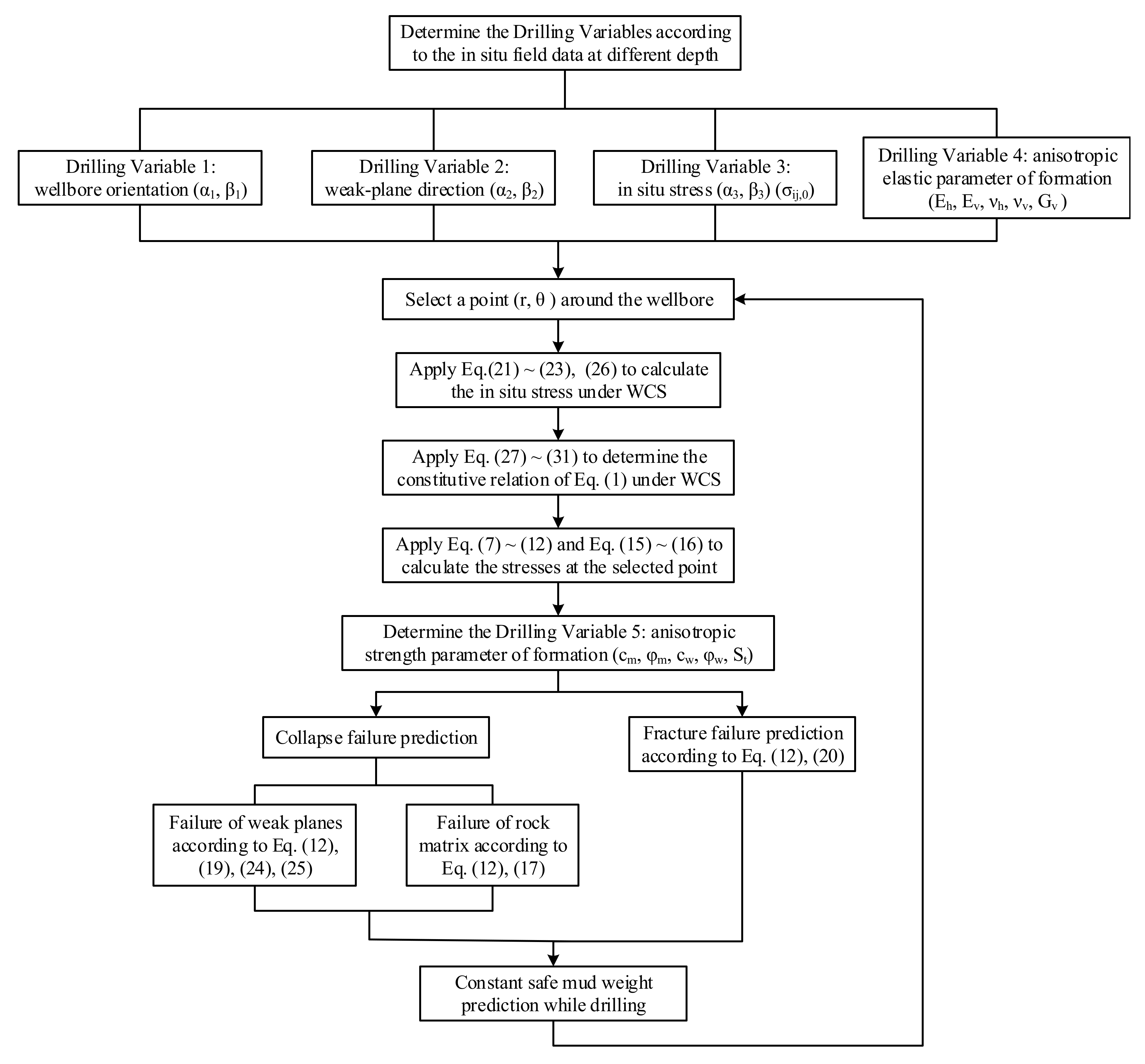
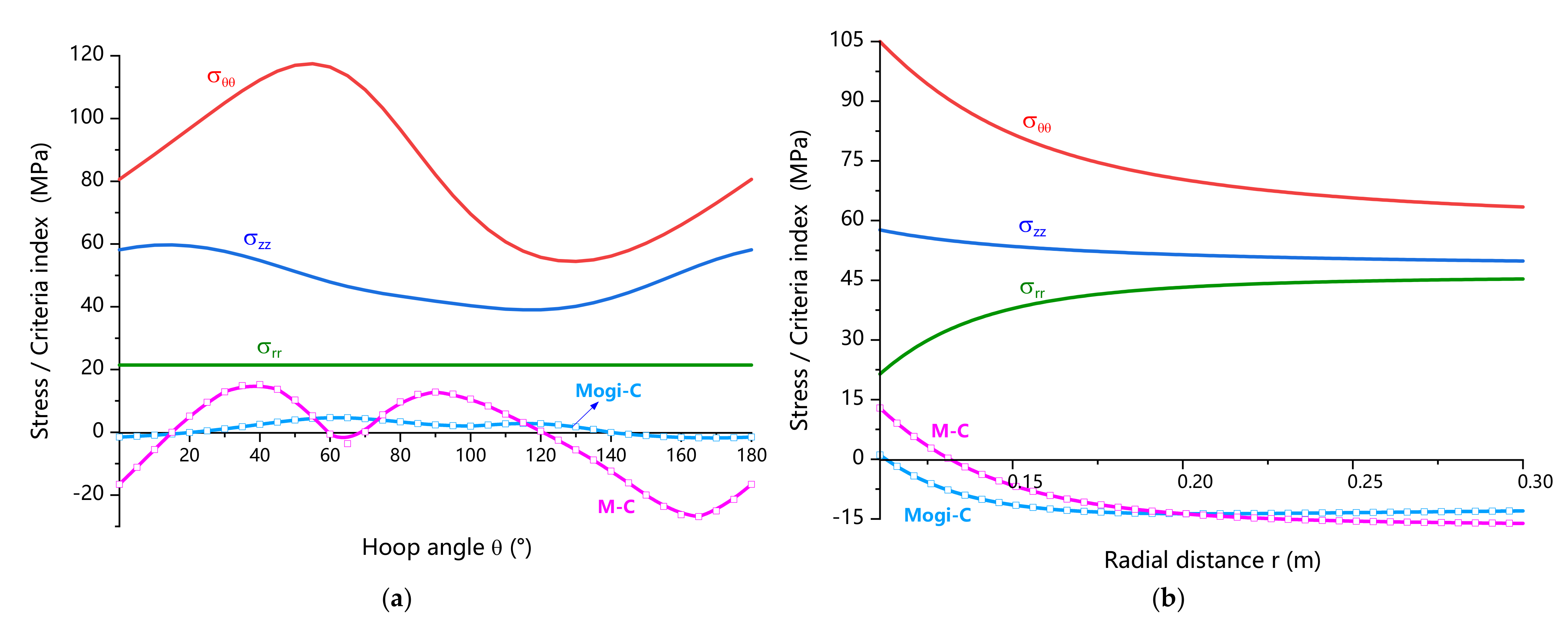


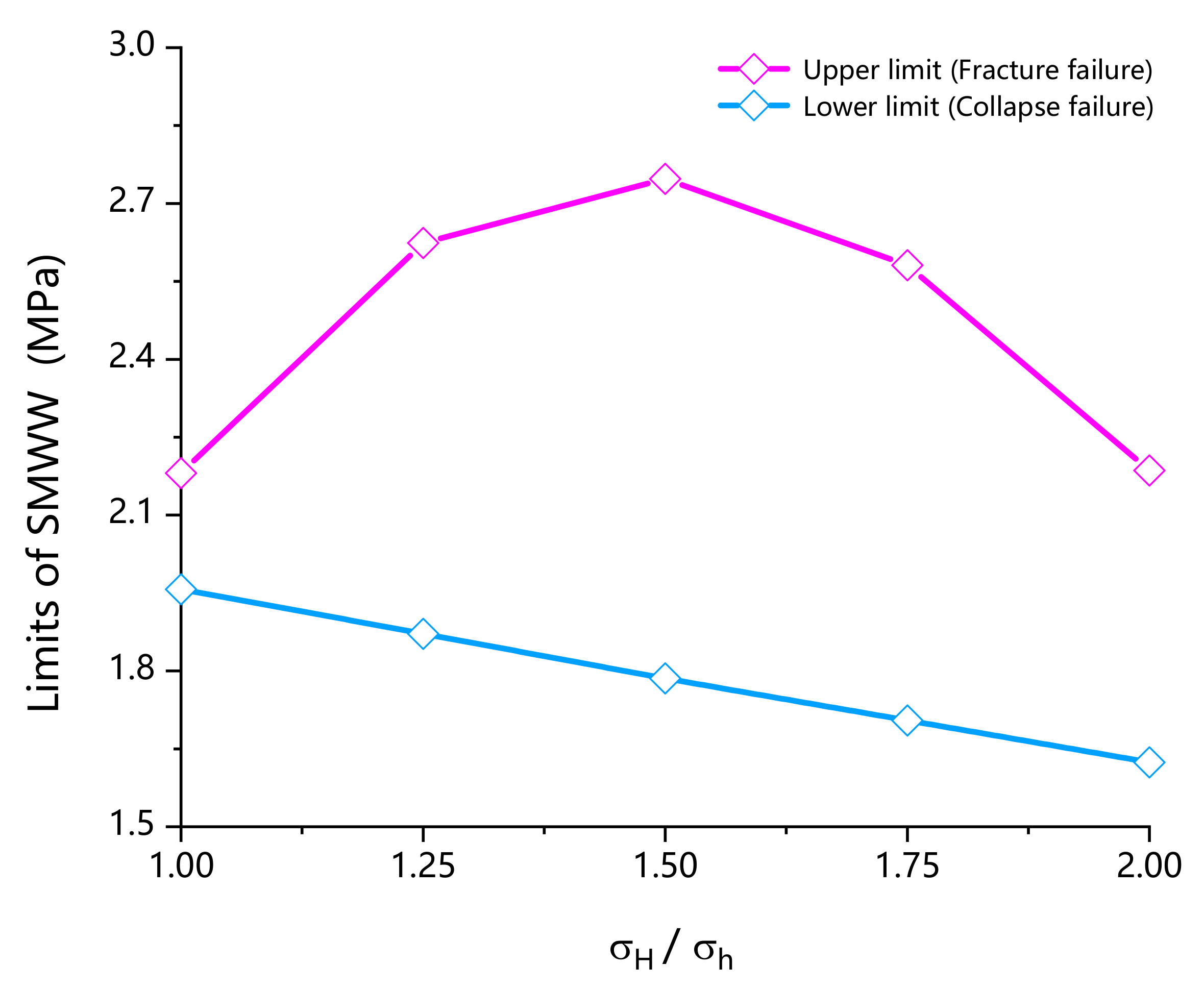
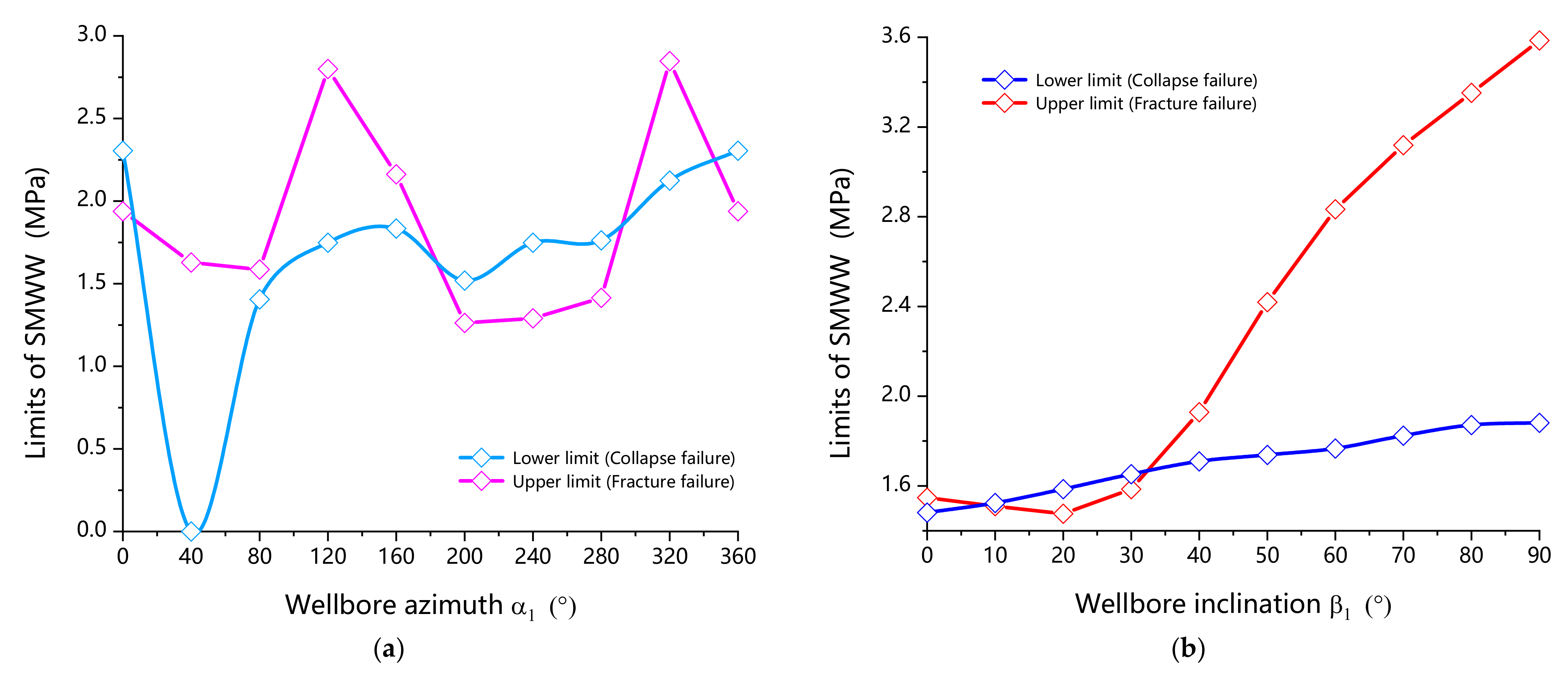
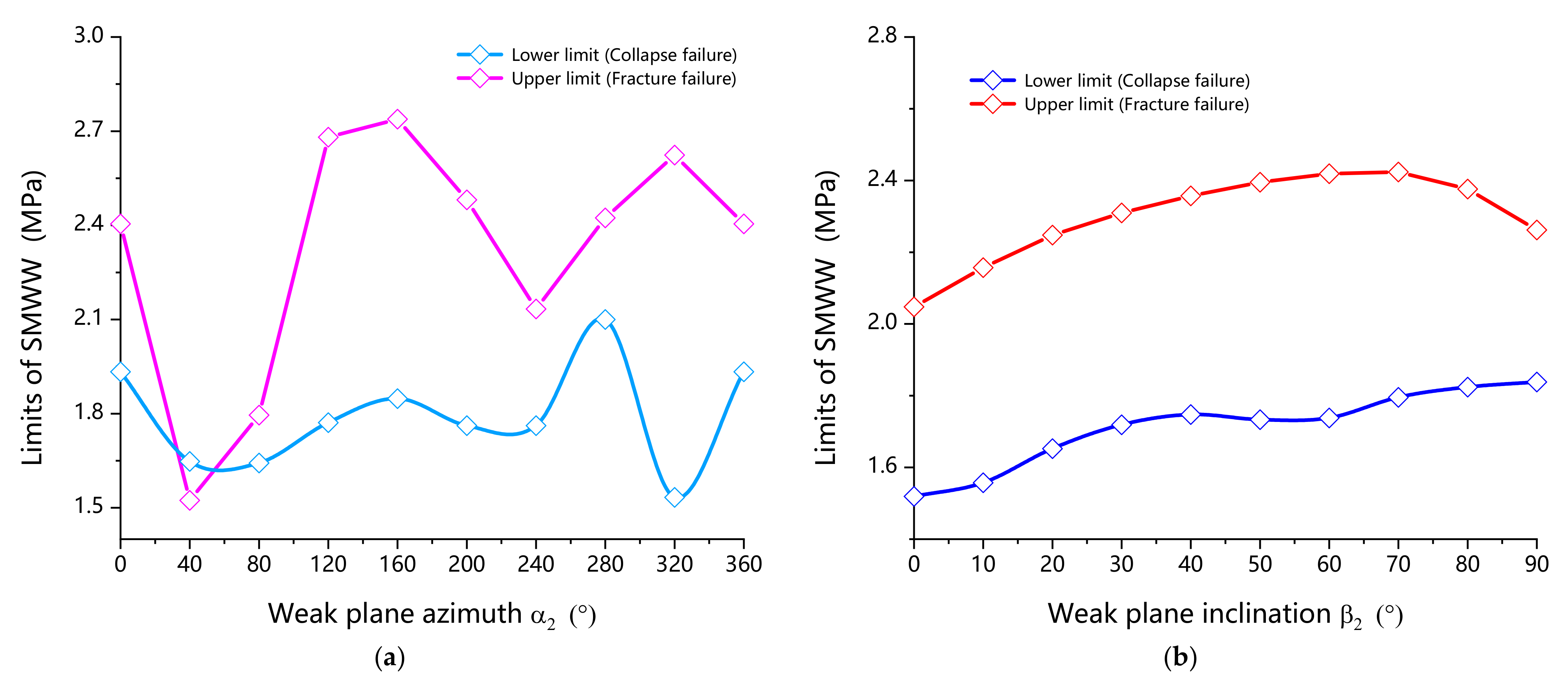

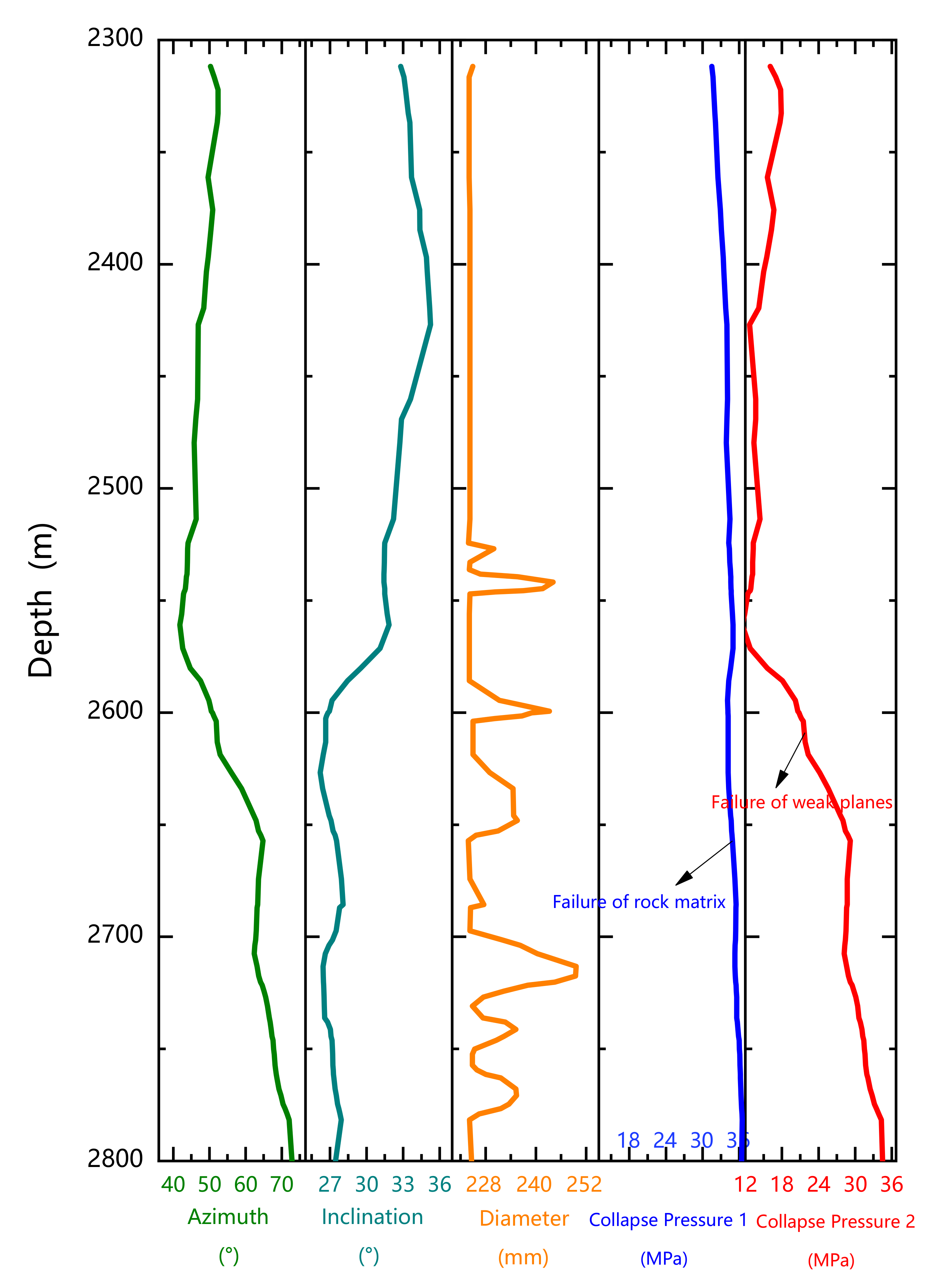
| Item | Value/Unit |
|---|---|
| Wellbore depth | 2100 m |
| 0.1 m | |
| 28 MPa/km | |
| 15 MPa/km | |
| 30 MPa/km | |
| 9.8 MPa/km | |
| 1.02 g/cm3 | |
| Orientation of in situ stress | = 0° |
| Orientation of wellbore | = 50° |
| Orientation of bedding planes | = 60° |
| Horizontal Young’s modulus of rocks | 31,170 MPa |
| Vertical Young’s modulus of rocks | 15,420 MPa |
| Horizontal Poisson’s ratio of rocks | 0.079 |
| Vertical Poisson’s ratio of rocks | 0.3 |
| 7050 MPa | |
| Biot’s effective stress coefficient | 1 |
| 4.3 MPa | |
| 30° | |
| 0.1 MPa | |
| 25° | |
| 0 MPa |
Publisher’s Note: MDPI stays neutral with regard to jurisdictional claims in published maps and institutional affiliations. |
© 2021 by the authors. Licensee MDPI, Basel, Switzerland. This article is an open access article distributed under the terms and conditions of the Creative Commons Attribution (CC BY) license (https://creativecommons.org/licenses/by/4.0/).
Share and Cite
Ding, L.; Wang, Z.; Lv, J.; Wang, Y.; Liu, B. A New Model for Real-Time Prediction of Wellbore Stability Considering Elastic and Strength Anisotropy of Bedding Formation. Energies 2022, 15, 251. https://doi.org/10.3390/en15010251
Ding L, Wang Z, Lv J, Wang Y, Liu B. A New Model for Real-Time Prediction of Wellbore Stability Considering Elastic and Strength Anisotropy of Bedding Formation. Energies. 2022; 15(1):251. https://doi.org/10.3390/en15010251
Chicago/Turabian StyleDing, Liqin, Zhiqiao Wang, Jianguo Lv, Yu Wang, and Baolin Liu. 2022. "A New Model for Real-Time Prediction of Wellbore Stability Considering Elastic and Strength Anisotropy of Bedding Formation" Energies 15, no. 1: 251. https://doi.org/10.3390/en15010251






